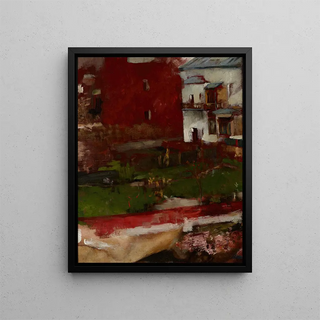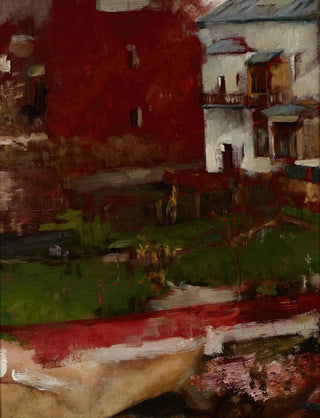City Buildings I - Olga Boznańska Art print


View from behind

Frame (optional)
Reproduction of City Buildings I - Olga Boznańska – Captivating Introduction
The artwork "City Buildings I" by Olga Boznańska is a piece that transports the viewer into a universe where architecture and light intersect in a striking manner. In this depiction, the artist manages to capture the very essence of a city, revealing both its dynamism and tranquility. The buildings, although frozen in time, seem to vibrate under the influence of subtle light, creating an atmosphere that is both nostalgic and contemporary. Boznańska, with her delicate approach and keen sense of observation, invites us to explore architectural details while reflecting on our relationship with urban space.
Style and uniqueness of the work
Olga Boznańska's style is undeniably marked by an impressionist sensibility, where color and light play a leading role. In "City Buildings I," shades of blue and gray blend harmoniously, evoking a palette that is both soothing and dynamic. The artist uses lively brushstrokes to bring the facades of the buildings to life, while maintaining a certain abstraction that allows the viewer to interpret the artwork in their own way. This singularity is also evident in the composition, where the straight lines of the buildings contrast with more organic shapes, suggesting a dialogue between man and his environment. Boznańska thus succeeds in creating a contemplative atmosphere, inviting everyone to reflect on the beauty of architecture and its impact on our daily lives.
The artist and her influence
Olga Boznańska, a prominent figure in early 20th-century Polish art, established herself through her unique style and artistic vision. Trained at the Academy of Fine Arts in Kraków, she was influenced by impressionist and post-impressionist movements, but also incorporated elements of Polish tradition into her work. Her ability to capture light and emotion through her paintings made her a respected artist both in Poland and abroad. Boznańska often explored themes related to

Matte finish

View from behind

Frame (optional)
Reproduction of City Buildings I - Olga Boznańska – Captivating Introduction
The artwork "City Buildings I" by Olga Boznańska is a piece that transports the viewer into a universe where architecture and light intersect in a striking manner. In this depiction, the artist manages to capture the very essence of a city, revealing both its dynamism and tranquility. The buildings, although frozen in time, seem to vibrate under the influence of subtle light, creating an atmosphere that is both nostalgic and contemporary. Boznańska, with her delicate approach and keen sense of observation, invites us to explore architectural details while reflecting on our relationship with urban space.
Style and uniqueness of the work
Olga Boznańska's style is undeniably marked by an impressionist sensibility, where color and light play a leading role. In "City Buildings I," shades of blue and gray blend harmoniously, evoking a palette that is both soothing and dynamic. The artist uses lively brushstrokes to bring the facades of the buildings to life, while maintaining a certain abstraction that allows the viewer to interpret the artwork in their own way. This singularity is also evident in the composition, where the straight lines of the buildings contrast with more organic shapes, suggesting a dialogue between man and his environment. Boznańska thus succeeds in creating a contemplative atmosphere, inviting everyone to reflect on the beauty of architecture and its impact on our daily lives.
The artist and her influence
Olga Boznańska, a prominent figure in early 20th-century Polish art, established herself through her unique style and artistic vision. Trained at the Academy of Fine Arts in Kraków, she was influenced by impressionist and post-impressionist movements, but also incorporated elements of Polish tradition into her work. Her ability to capture light and emotion through her paintings made her a respected artist both in Poland and abroad. Boznańska often explored themes related to






